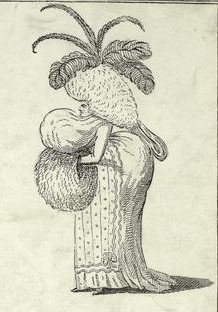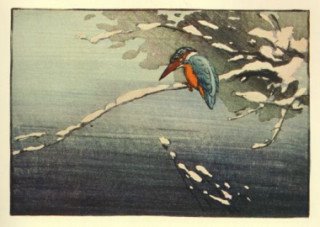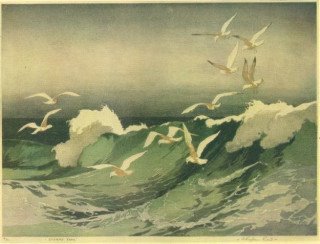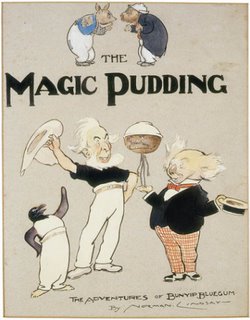


Kanae Yamamoto (1882-1946) was a founder of the Japanese art movement, Sosaku Hanga or 'creative prints'. It was "a Japanese woodblock print movement of the 20th century which utilized Western concepts of art; both in the production, in which the artist was more involved in the production of the prints (often undertaking the entire process on their own), and in the subject matter and presentation, which was that of modern art."
Yamamoto went to France to study oil painting for 4 years and in 1917, returned to Japan via the revolutionary upheaval in Russia. He caught the socialist bug and set up utopian art schools back home for children and the proletarian class. These projects chanelled his energies away from his own artistic pursuits however and his most productive years were already behind him. He destroyed most of his print blocks with a hatchet before his death.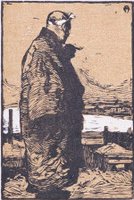 Last night I found myself in a website about which I knew nothing and after scanning the artistic contents and doing some searching I finally found out that it was the Kanae Yamamoto Museum in Ueda -- this link takes you directly to his artworks which include sketches, oil paintings and woodblock prints. There's no english but it's easy to follow and they have large jpegs of each image available.
Last night I found myself in a website about which I knew nothing and after scanning the artistic contents and doing some searching I finally found out that it was the Kanae Yamamoto Museum in Ueda -- this link takes you directly to his artworks which include sketches, oil paintings and woodblock prints. There's no english but it's easy to follow and they have large jpegs of each image available.
Kanae Yamamoto biography.
Sosaku Hanga art movement.
[That's the first Sosaku Hanga print ever made from 1904 by Yamamoto, at left]
Saturday, November 12, 2005
Yamamoto and the Sosaku Hanga
Found Insects






Would it were that my papers were of such magnitude and quality that I could stumble across 261 lithographic plates of insects. Joseph R Stulb believes these plates of Orthoptera, Hemiptera, Coleoptera, Diptera, Lepidoptera, and Hymenoptera were either owned by his American grandfather educated in Heidelburg or his great grandfather from Bavaria. It is estimated they were made sometime between 1830 and 1890.
Stulb donated the lithographs to the Academy of Natural Sciences Library who host them on their firefox-incompatible website (it's a sizeable pageload despite these being thumbnail pictures). The images here are all details and the quoted scientific names are in the image URLs.
Friday, November 11, 2005
Wood Blocking
These colour woodblock prints are all from the early 20th century and were found among the exhibitions online at the wonderful Woodblock website run by David Bull. If you like woodblocks or have an interest in printing, there are a lot of things to see including transcripts from a number of books, techniques for woodcarving and printing, many example woodblock images of course and even a woodblock-cam (ok, the site is a couple of years old) and current weblog about David's work.
The Hudson
Jacques Milbert: Itinéraire pittoresque du fleuve Hudson et des parties latérales de l'Amérique du Nord..
William Guy Wall/John Hill: The Hudson River Port Folio.
These images come from A Hudson River Portfolio: Prints, at the NYPL.
Erbario Alchemico



Ulissi Aldrovandi (Aldrovandus) (1522-1605) graduated from Padua and Bologna Universities with degrees in law, philosophy and medicine and taught logic to supplement the occasional patronage bestowed on him by his cousin, the Pope.
During nearly a year of confinement in Rome while fighting a heresy charge, Aldrovandi developed a strong interest in the natural world. He began to collect all manner of specimens which apparently came to constitute a formidable natural history museum for those that visited him.
He travelled quite a bit in his quest for specimens and recorded his observations in some 4000 manuscripts, a number of which were published during his lifetime. His writings include studies in ornithology, medicine, hydrology, zoology, botany and, as can be imagined from the embellished and fantastical images here, a paper on mythical creatures as well (among others).
Aldrovandi was instrumental in establishing the botanical gardens in Bologna and his alma mater there awarded him the first Professorial chair in natural science. However, even with a sympathetic view towards this stereotypical renaissance polymath, much of his work is erroneous at best and positively surreal at times. The images here are from Erbario Alchemico, a 26 page illustrated manuscript that purports to document many of the important plants associated with alchemy.
- The University of Bologna retains some 3,500 of Aldrovandi's manuscripts and Erbario Alchemico is online at their librit website [click on the second title from the top to launch the viewing browser]
- The italian-only Aldrovandi website. (they appear to have about 18 manuscripts online in the archives section now)
- Some biographical information.
- Misteraitch's entries on Aldrovandi at Giornale Nuovo: one, two.
Thursday, November 10, 2005
The Magic Lindsay
Norman Lindsay (1879-1969) was an author, painter, illustrator, sculptor and model ship builder and one of Australia's most renowned artist. His predeliction for nudes in many of his paintings and his right wing political views ensured his public reputation was controversial.
He was an editorial cartoonist for a political magazine for a long time where caricatures were churned out but he was also a prolific sketcher and his pen and pencil drawings are exquisite. His arguably greatest success derives from the 1918 publication of The Magic Pudding, a fantastical children's book classic in which a sailor, a penguin and Bunyip Bluegum the koala team up with a magical pie that never runs out.
- The original pencil, ink and watercolour sketches for The Magic Pudding at the State Library of NSW
- Etchings at GreenHill Galleries
- The pen drawings of Norman Lindsay at DropBears
- Norman Lindsay Gallery and Museum
- Fine Arts Museum of San Francisco
- Rare books by or about Norman Lindsay
- Book covers
- Bio and example images
- More paintings and a sketch
- Sample watercolours
- Thumbnails of other etchings
- Wikipedia
Wednesday, November 09, 2005
Pleasured by Pyrotechnia





John Babington was employed by the Earl of Newport, Master of His Majesty's Ordnance for King Charles I. This obviously gave him perfect access to the technologies of the day with respect to all manner of explosive materials. Although there had been previous books addressing pyrotechnics, the treatise produced by Babington on the subject in 1635 went much further than previous works and holds the distinction of being the first english study of fireworks in a recreational setting. [The latter part of the book deals with geometry]
In his Pyrotechnia, or a discourse of Artificiall Fire-works: In which the true Grounds of that Art are plainly and perspiciously laid downe, Babington "provided directions for making rockets, stars, wheels, and ground-wheels that were more explicit than any offered by previous writers. He was, however, at his best when describing the complex devices and intricate displays in which his age delighted. Some of the chapter headings indicate the ambitious nature of his efforts: The manner of composing a wheele, which having finished his revolution, shall represent a Coat of Armes; How to compose a Castle of Fireworks: How to represent Saint George fighting with a Dragon on the line; and How to make a Water Ball, which, after a certain time of firing, shall cast forth divers rockets into the ayre."

- Babington's Pyrotechnia, or a discourse of Artificiall Fire-works is online in its entirety at the (fabulous) ECHO Project website (European Cultural Heritage Online, hosted by the Max Planck Institute) as part of the Archimides Project.
- Science and Society's quick and abbreviated thumbnail set of images from Pyrotechnia.
- A short overview: War By Other Means: the Art and Science of Fireworks in Europe, 1500-1850.
- History of Fireworks and Gunpowder: a short essay.
- Brown University's Paul R Dupree collection of fireworks books exhibition.
- Wikipedia on fireworks.
- Pyrotechics Guild International.
- The new Gunpowder Plot: Parliament & Treason 1605 website about the Guy Fawkes episode.
On the Origins of Modernity
Telluris theoria sacra
Thomas Burnet
1684
The Life and Strange Surprizing Adventures
of Robinson Crusoe of York, Mariner
Daniel Defoe
1720
Bybel der Nature
Jan Swammerdam
1758
Sydney University's Origins of Modernity from their Rare Books Collection traces the development of modern thought and culture through many of the most influential natural science, philosophy, literature, medicine, alchemy and astronomy books issued during the last few centuries.

